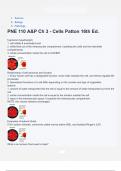Exam (elaborations)
Science Biology Pathology PNE 110 A&P Ch 3 - Cells Patton 16th Ed Questions & answers latest update 2024/2025 with complete solution
- Course
- Institution
- Book
Science Biology Pathology PNE 110 A&P Ch 3 - Cells Patton 16th Ed Questions & answers latest update 2024/2025 with complete solution
[Show more]



